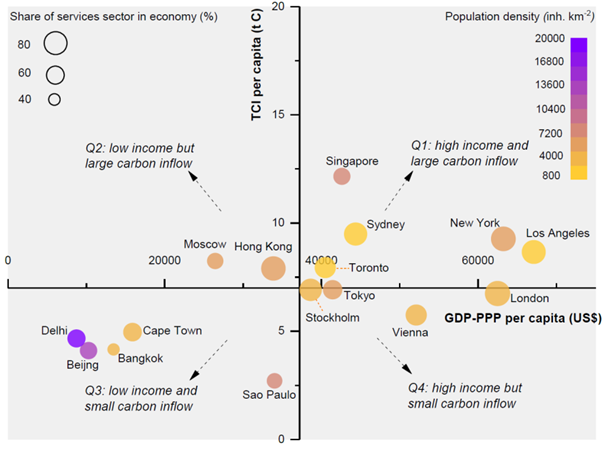Supported by the National Natural Science Foundation of China (Grant No. 71725005, 71704015, 71874097 and 71961137009), the collaboration between Prof. Bin Chen from Beijing Normal University and researchers from University of Maryland, Groningen University and Tsinghua University, has achieved significant progress on research area of urban eco-environmental management. This study, titled Physical and Virtual Carbon Metabolism of Global Cities, has been published in Nature Communications in January 2020 (http://www.nature.com/articles/s41467-019-13757-3#Ack1).
Cities play an important role in the global carbon balance and in tackling climate change due to their intensive economic activities. In order to achieve the 1.5°C temperature goal of the Paris Agreement and Sustainable Development Goals of the United Nations, it is urgent to explore the roadmaps of low-carbon development at the city level. The current framework has modeled both physical carbon and virtual carbon associated with an urban economy to capture gaseous carbon emissions within or across city boundaries. Physical carbon stocks, natural sinks, and fluxes in products within urban settlements are incorporated to investigate their potential impacts on global carbon cycle. Particularly, a consistent metabolic process-based model that combines physical carbon balance and fossil fuel-derived gaseous carbon footprint, is established to track carbon processes coming into, being added to the urban stocks, and eventually leaving the city. This proposed framework could provide new insights into the carbon emission mitigation strategies of urban areas and offer differentiated policy options for a global deep urban decarbonization.
The results show that due to the significant differences on income level, urban form and infrastructure scale, four quadrants can be identified based on the magnitude of per capita carbon inflow and urban income, demonstrating clusters of cities with high-income and high-carbon inflows, low-income but high carbon inflows, low-income and low-carbon inflows, and high-income but low-carbon inflows. It is found that managing the urban stocks during their lifetime, especially those linked to investment in housing, production facilities and infrastructure, will promote the on-going climate change mitigation efforts. Therefore, to develop a low-carbon or even zero-carbon society, it is critical that not only carbon emissions emitted into the atmosphere, but also carbon embodied in urban stocks, should be pinpointed for stabilizing the future global climate.

Fig: Distribution of 16 global cities by per capita total carbon inflow and per capita GDP-PPP.

Add: 83 Shuangqing Rd., Haidian District, Beijing, China
Postcode: 100085
Tel: 86-10-62327001
Fax: 86-10-62327004
E-mail: bic@donnasnhdiary.org
京ICP备05002826号 文保网安备1101080035号 Copyright 2017 NSFC, All Right Reserved